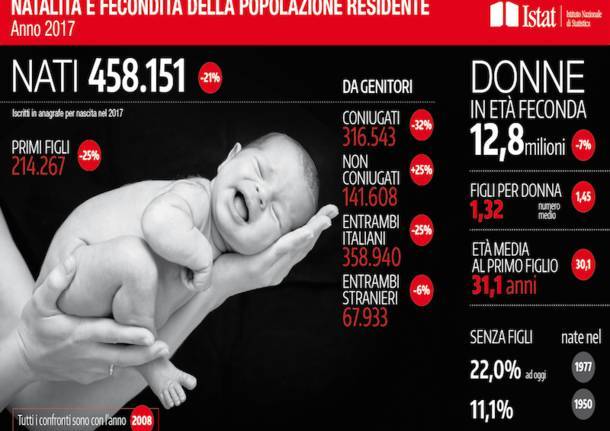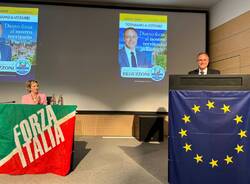In Italy the birthrate is falling
In 2017, 458,151 children (100,000 from foreign parents) were registered in the civil registry, 15,000 less than in 2016 and 120,000 in 2008.

The birthrate has fallen by 21%, over ten years. The official Istat data on birthrates are worrying because they indicate a structural situation with a decrease of more than 120,000 babies born compared to 2008.
In 2017, 458,151 children were registered in the civil registry, 15,000 less than in 2016. Childbirth has dropped about 45,000 units over three years (from 2014 to 2017). The phase of childbirth’s falling triggered by the crisis that began in 2008 therefore seems to have acquired structural characteristics.
The declining female population between 15 and 49 years (about 900,000 fewer women) observed between 2008 and 2017 explains almost three quarters of the difference in childbirth that occurred in the same period. The remaining portion depends on the ever-lower levels of fertility.
The decrease of birthrate is particularly accentuated for the sets of parents who are both Italian, dropping to 358,940 in 2017 (15,000 less than in 2016 and 120,000 less than in 2008).
Compared to 2008, the number of children born to married couples has decreased significantly: in 2017 there were 316,543 (less than 147,000 only in 9 years). This sharp decline is partly due to the trend of marriages, that reached their lowest level in 2014, a year in which only 189,765 marriages were celebrated (less than 57,000 compared to 2008) and in order to then slightly bounce back to exceed 200,000 marriages in 2016. In 2017 there was a further decrease (191,287 marriages).
In particular, the propensity to the first marriage, which has been decreasing for years, after showing a slight recovery from 2015 came to a standstill in 2017 (419.0 marriages per thousand men and 465.1 first marriages per thousand women).
In a context of decreasing births, those that occurred outside the marriage increase by almost 29,000 units compared to 2008, reaching 141,608. Their relative weight continues to grow, reaching 30.9% in 2017.
The declining birth rate is mainly related to the first-born children (214,267 in 2017), with a 25% decline compared to 2008. In the same period of time, the number of children following the first-born fell by 17%.
From 2012 to 2017, also those born to at least one foreign parent decreased (-8 thousand), with a thousand fewer units only in the last year, falling below 100 thousand (99,211, 21.7% of the total of those born) for the first time since 2008. Among these, there was a decline, especially in the number of those born to both foreign parents: in 2016, for the first time, births were below 70,000, and they fell further in 2017 (67,933).
With the highest number of foreign births reported in the Civil Registry, Romania confirms its position (14,693 born in 2017), followed by Morocco (9,261), Albania (7,273) and China (3,869). These four communities represent 51.8% of the total number of foreign births.
In 2017, the trend towards a decrease in fertility, which has been underway since 2010, continued. The average number of children per woman dropped to 1.32 (1.46 in 2010). Italian women have an average of 1.24 children (1.34 in 2010), while foreign citizens have an average of 1.98 (2.43 in 2010).
The reduction in the average number of first-born children per woman between 2010 and 2017 is responsible for 68% of the overall decrease in fertility of Italian women and for 81% of that of foreign women.
Considering the generations, the average number of children per woman decreases without interruption. They range from 2.5 children of those born in the early 1920s (i.e. immediately after the Great War), to 2 children of the generations immediately after the Second World War (1945-49), up to the estimated level of 1.44 children for women of the 1977 generation.
At the same time, there is a marked increase in the proportion of women without children: in the 1950 generation it was 11.1%, in the 1960 generation it was 13% and in the 1977 generation it is estimated that it will reach (at the end of its reproductive life cycle) 22.0%.
TAG ARTICOLO
La community di VareseNews
Loro ne fanno già parte
Ultimi commenti
flyman su Ilaria Salis candidata alle europee con Alleanza Verdi Sinistra nel collegio NordOvest
Alberto Gelosia su Ilaria Salis candidata alle europee con Alleanza Verdi Sinistra nel collegio NordOvest
lenny54 su I no vax sono tornati a colpire in provincia: imbrattati i muri della redazione di Varesenews
malauros su I no vax sono tornati a colpire in provincia: imbrattati i muri della redazione di Varesenews
Felice su I no vax sono tornati a colpire in provincia: imbrattati i muri della redazione di Varesenews
PaoloFilterfree su A Varese Salvini prova a ricucire passato e futuro della Lega, ma Bossi non c'è














Accedi o registrati per commentare questo articolo.
L'email è richiesta ma non verrà mostrata ai visitatori. Il contenuto di questo commento esprime il pensiero dell'autore e non rappresenta la linea editoriale di VareseNews.it, che rimane autonoma e indipendente. I messaggi inclusi nei commenti non sono testi giornalistici, ma post inviati dai singoli lettori che possono essere automaticamente pubblicati senza filtro preventivo. I commenti che includano uno o più link a siti esterni verranno rimossi in automatico dal sistema.